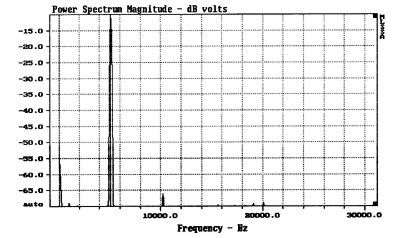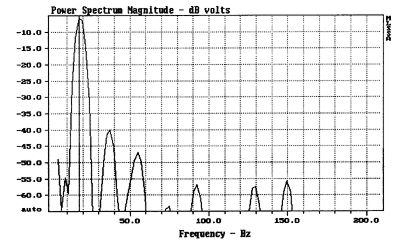| Columns Retired Columns & Blogs |
Wilson Audio Specialties X-1/Grand SLAMM loudspeaker system Measurements
Sidebar 3: Measurements
Footnote 1: The combination of sensitivity and impedance gives us an idea of a more worthwhile specification: efficiency, which tells us how effective the speaker is at converting electrical input power into acoustic power.—Martin Colloms
Incorporated in this speaker's title is the term "Super Linear," which implies low distortion. It certainly sounded as if it should have low distortion, but would the X-1/Grand SLAMM really measure better than typical moving-coil designs? Characteristic distortion measurements in loudspeaker reviews are often made at more than one sound-power level: 86dB at 1m is a typical midrange sound level on music and natural speech; 96dB is quite loud—loud enough for most purposes, in practice; 100dB is quite often the upper working limit for miniature speakers; while 106dB is generally considered flat out for most designs, and may cause damage with a continuous sinewave measurement.
Most speakers are linear at 86dB, even down into the upper bass, where the harmonic distortion is predominantly low-order second- and third-harmonic typically in the 0.3-0.5% range (-46 to -50dB). Below 100Hz—the true bass range—the distortion is generally rather higher, and varies according to the speaker's design, size, and bass loading. It's fortunate that our aural sensitivity to distortion reduces with frequency, helping loudspeakers out where they need it most.
For example, the B&W Silver Signature reviewed in Stereophile last June (Vol.17 No.6, p.75) delivers quite typical distortion values when driven by a 100Hz sinewave at 86dB spl (fig.1). The second harmonic lies at -40dB (1%), the third at -53dB (0.2%), with negligible higher harmonics. At 50Hz, the results would be around 6dB poorer. In the midband (fig.2), the figures for second and third harmonics are reversed for this particular speaker, reading -45dB and -55dB, respectively. These harmonics will be proportionally higher in level at the louder 96dB level. For a 100Hz tone in the upper bass at the 96dB spl sound level, the third harmonic will now lie at -40dB (1%), the second at -31dB (about 3%).

Fig.1 B&W Silver Signature, spectrum of 100Hz sinewave, DC-1kHz, 2.83V drive signal (linear frequency scale, 10dB/vertical div.).

Fig.2 B&W Silver Signature, spectrum of 1kHz sinewave, DC-10kHz, 2.83V drive signal (linear frequency scale, 10dB/vertical div.).
These readings are on the threshold of audibility for pure sinewaves, but a greater sound-pressure level of 100dB or more will be required before this level of distortion would actually be audible on music. The complex harmonic waveforms in music strongly mask low-order distortion products.
These quite normal figures are quoted for this high-performance moving-coil speaker to highlight the results for the X-1/Grand SLAMM and to explore its claim for high linearity. Taking 100Hz first, at an 86dB sound level, the Wilson measured very cleanly indeed, with the second harmonic at -70dB (0.03%), the third at -58dB (almost 0.1%). This was substantially better than usual; even the "low-distortion" Velodyne DF-661 (see Stereophile, June 1994, Vol.17 No.6, p.77) doesn't compete in the upper bass. Over the 86dB-96dB range and up to the highest 106dB loudness, the X-1's third harmonic remained unchanged at around 0.1% (-60dB). Not unexpectedly, the second harmonic progressively lost ground as the spl increased, but this was to a still-state-of-the-art 0.2% (-54dB) at the highest test level (fig.3).

Fig.3 Wilson X-1/Grand SLAMM, spectrum of 100Hz sinewave, DC-500Hz, at 96dB spl (solid) and 106dB (dotted) (linear frequency scale, 5dB/vertical div.).
These results were no flukes; for example, at 500Hz, the province of the paralleled pair of 7" midrange drivers, a 96dB spl test level was dispatched with disdain, generating a mere -65dB of second harmonic, with the third harmonic at better than -55dB. (I needed ear defenders for testing the Wilson at these higher levels!)
With a 1kHz tone at 96dB, there was a mild increase in third-harmonic distortion to -50dB, with the second still better than -65dB. Moving into the treble range, to 5kHz, the upper 96dB test level resulted in a truly negligible amount of second harmonic (-66dB, 0.05%), and everything else was down at -70dB or better—another great result (fig.4). This upper-region distortion performance is comparable to that of a classic, high-linearity, push-pull electrostatic panel.

Fig.4 Wilson X-1/Grand SLAMM, spectrum of 5kHz sinewave, DC-30Hz, at 96dB spl (linear frequency scale, 5dB/vertical div.).
Matters got really serious in the bass. Clearly, 50Hz was going to be too easy for the big SLAMM, so a low 24Hz was chosen (peak port output), first at 96dB (where most speakers are already dead in the water), and then at 106dB. At 96dB, the second harmonic was an amazingly good -50dB (0.3%), the third a very creditable -44dB (0.6%). At 106dB, the X-1 was still kicking hard, the second harmonic of the 24Hz tone lying at -32dB, the third at -27dB. Many big speakers have low-frequency distortion more than 40dB higher at this point; in other words, the distortion power is greater than the fundamental—a phenomenon called "doubling."
Earthquake Bass: By this time I was fully confident of the X-1's abilities, so drove it with an infrasonic 18Hz fundamental at a nominal 106dB sound-pressure level (fig.5), the latter referenced to the level at 24Hz. I found that genuine high-power output was possible into the ultra-low bass. Even with the punishing 18Hz signal, the second harmonic was quite inaudible at -40dB (1%), with the third very low at -47dB (0.4%)—a quite remarkable performance. Well, the experts always told us that for good bass you needed a big box and big cones; you certainly get them with the X-1!

Fig.5 Wilson X-1/Grand SLAMM, spectrum of 18Hz sinewave, DC-200Hz, at 106dB spl (linear frequency scale, 5dB/vertical div.).
Sensitivity & Loading: Checked under various weightings, the X-1's sensitivity checked out spot on target at 95dB for an 8 ohm watt (2.83V) at 1m. Its clean "attack" and good midrange and treble directivity could make this speaker appear subjectively even louder than this. Peak input powers of up to 500W on sensible, wide-range program material gave no signs of mechanical or acoustic stress (out came the ear defenders again, though). Thus, a stereo pair in a typical listening room can give a dynamic range of up to 122dB at 1m, or 117dBA in-room. With the X-1/Grand SLAMM you can reproduce a full orchestra at realistic levels in your living room. Its power capability is such that if you want an amplified rock group in your lounge, you can have that, too.
Amplifier loading goes hand in hand with sensitivity. Any designer can grab another 3dB of specified "8 ohm" sensitivity by halving the rated system impedance and thereby pulling twice the current from the amplifier. Such low impedances may be prejudicial to some amplifiers; I prefer a sensible balance between voltage sensitivity (referenced to 8 ohms) and load impedance (footnote 1).
The late James Moir had a good approach to this problem, using a pink-noise stimulus to calculate the RMS impedance modulus over the frequency range in question. An input power of 1W was measured into this broad-band, real-world impedance, and loudspeaker sensitivities could then be rated against this standard watt. Standardizing this method might help to discourage speaker designers tempted to follow the low-impedance route.
In the event, the Wilson presents a relatively easy load to an amplifier (fig.6). It's not quite classifiable as an "8 ohm" loudspeaker, which is defined as having a minimum magnitude of 6.4 ohms, though it comes close. For example, in music's main power band (120Hz-10kHz), the loading does not fall below 6 ohms, and averages 7.3 ohms. The magnitude does drop from 5 ohms at 15kHz to 3.2 ohms at 20kHz, which will give rise to some "dulling" of the treble balance both with SE-type amplifiers and with others featuring a higher-than-usual output impedance (1-3 ohms, say). Conversely, the X-1's commendably uniform mid-band impedance means that it will remain neutrally balanced with many tube power amplifiers.

Fig.6 Wilson X-1/Grand SLAMM, electrical impedance (top) and phase (bottom) (2 ohms/90 degrees/vertical div.). For reference, the value at 1kHz is 7 ohms.
A fall to just over 2 ohms can be seen above the audioband, but this isn't likely to be of much significance. At low frequencies, the lowest impedance value is a pretty harmless 4.6 ohms at 80Hz. It doesn't fall again until the minimum of 5 ohms at 24Hz—the well-damped port-tuning frequency.
The phase angle of the impedance gives an idea of the speaker's reactive content, where it's acting more like a capacitor (negative phase angle, or leading) or an inductor (positive angle, or lagging). Both cables and amplifiers prefer low reactance if they can get it. From 200Hz-3kHz, the X-1's reactance is almost zero and it doesn't exceed more than 40 degrees, 20Hz-20kHz. This implies that the load remains predominantly resistive over the whole of this wider frequency range. This further reinforces my approval of its good load characteristic.
Forward Frequency Responses: Measured on-axis at 45" (acknowledging that the speaker was aligned for a 4.5m listener range), the Grand SLAMM's frequency response in the upper-mid and the treble is not as flat as I might have hoped or expected (fig.7). It requires wider than usual limits to contain it: ±3.5dB. One-third-octave smoothing did allow my standard ±3dB limits to be applied over a wide frequency range, but those raw, unsmoothed axial variations cannot go unremarked.

Fig.7 Wilson X-1/Grand SLAMM, anechoic response on tweeter axis at 45" (solid curve) with dotted treble response on listening axis (see text). Dashed curves are: "A," the response of the rear-facing ambience tweeters; "P," the nearfield response of the port; "B," the combined nearfield response of the woofers; and "M," the nearfield response of the midrange units.
Footnote 1: The combination of sensitivity and impedance gives us an idea of a more worthwhile specification: efficiency, which tells us how effective the speaker is at converting electrical input power into acoustic power.—Martin Colloms
- Log in or register to post comments




































